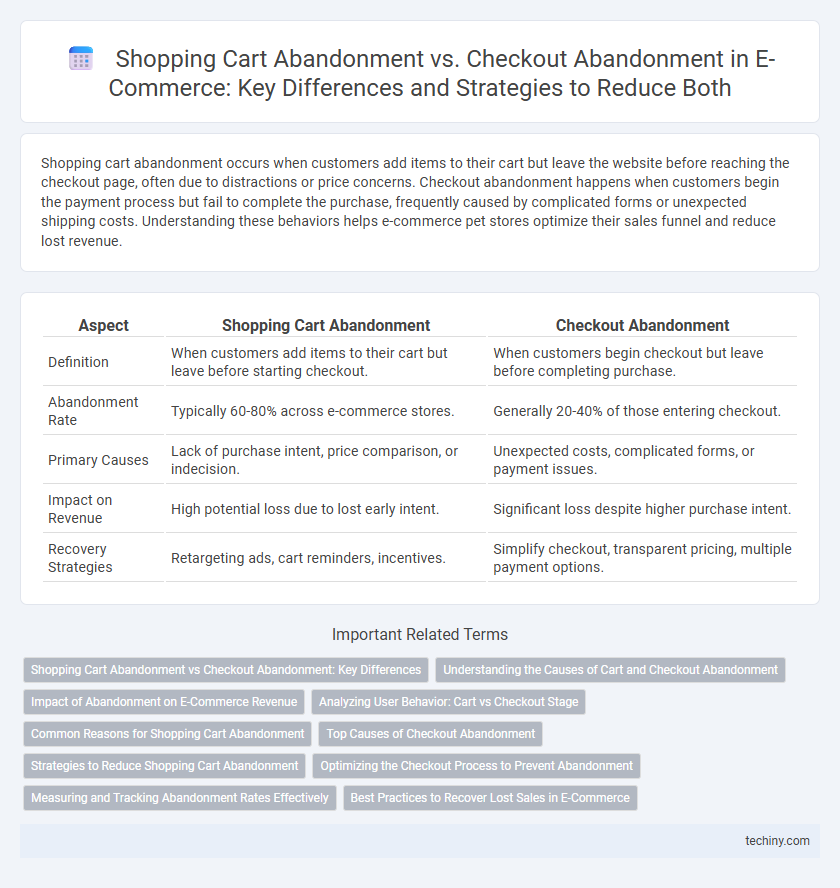Shopping cart abandonment occurs when customers add items to their cart but leave the website before reaching the checkout page, often due to distractions or price concerns. Checkout abandonment happens when customers begin the payment process but fail to complete the purchase, frequently caused by complicated forms or unexpected shipping costs. Understanding these behaviors helps e-commerce pet stores optimize their sales funnel and reduce lost revenue.
Table of Comparison
| Aspect | Shopping Cart Abandonment | Checkout Abandonment |
|---|---|---|
| Definition | When customers add items to their cart but leave before starting checkout. | When customers begin checkout but leave before completing purchase. |
| Abandonment Rate | Typically 60-80% across e-commerce stores. | Generally 20-40% of those entering checkout. |
| Primary Causes | Lack of purchase intent, price comparison, or indecision. | Unexpected costs, complicated forms, or payment issues. |
| Impact on Revenue | High potential loss due to lost early intent. | Significant loss despite higher purchase intent. |
| Recovery Strategies | Retargeting ads, cart reminders, incentives. | Simplify checkout, transparent pricing, multiple payment options. |
Shopping Cart Abandonment vs Checkout Abandonment: Key Differences
Shopping Cart Abandonment occurs when customers add products to their cart but leave before proceeding to checkout, reflecting initial interest without commitment. Checkout Abandonment happens when shoppers enter the checkout process but do not complete the purchase, often due to payment issues or complex forms. Understanding these behaviors helps e-commerce businesses tailor strategies to reduce drop-offs at different stages, improving conversion rates and revenue.
Understanding the Causes of Cart and Checkout Abandonment
Shopping cart abandonment occurs when customers add products to their cart but leave the site before initiating checkout, often due to unexpected costs or complex navigation. Checkout abandonment happens when users start the payment process but fail to complete the purchase, commonly caused by lengthy forms or limited payment options. Understanding that cart abandonment is influenced by hesitation and research behavior while checkout abandonment stems from transactional friction helps optimize conversion strategies in e-commerce.
Impact of Abandonment on E-Commerce Revenue
Shopping cart abandonment and checkout abandonment significantly reduce e-commerce revenue by decreasing conversion rates and lowering average order value. Cart abandonment occurs when customers add items but leave before initiating checkout, while checkout abandonment happens during the payment or review stage, both leading to lost sales opportunities. Implementing targeted strategies like retargeting emails and streamlined checkout processes can mitigate these losses and boost overall revenue performance.
Analyzing User Behavior: Cart vs Checkout Stage
Shopping cart abandonment occurs when users add products but leave before initiating checkout, highlighting issues like unexpected costs or lack of trust. Checkout abandonment happens later, during payment or shipping details entry, signaling friction in the final purchasing steps such as complicated forms or limited payment options. Analyzing user behavior at these specific stages helps pinpoint precise barriers, enabling targeted optimizations to improve conversion rates and reduce overall abandonment.
Common Reasons for Shopping Cart Abandonment
High shipping costs, complicated checkout processes, and lack of trust in payment security are common reasons for shopping cart abandonment in e-commerce. Unexpected additional fees and slow website loading times frequently discourage shoppers from completing their purchases. Improving user experience and transparency can significantly reduce abandonment rates and increase conversion efficiency.
Top Causes of Checkout Abandonment
Checkout abandonment primarily stems from unexpected costs like high shipping fees, complicated payment processes, and mandatory account creation, which disrupt the user experience. Technical issues such as slow page load times and website errors also significantly contribute to users abandoning their shopping carts during checkout. Addressing these issues by streamlining payment options, providing transparent pricing, and optimizing website performance can drastically reduce checkout abandonment rates in e-commerce.
Strategies to Reduce Shopping Cart Abandonment
Shopping cart abandonment occurs when customers add products to their cart but leave before reaching the checkout phase, whereas checkout abandonment happens during the checkout process itself. Effective strategies to reduce shopping cart abandonment include optimizing website speed, simplifying navigation, offering guest checkout options, and displaying clear shipping costs upfront. Personalized email reminders and retargeting ads also significantly increase conversion rates by encouraging users to complete their purchases.
Optimizing the Checkout Process to Prevent Abandonment
Optimizing the checkout process significantly reduces both shopping cart abandonment and checkout abandonment by streamlining user experience, minimizing form fields, and offering multiple secure payment options. Implementing progress indicators and guest checkout can accelerate transaction completion, while personalized reminders and cart recovery emails address hesitation at the final purchase stage. Data-driven insights into user behavior allow e-commerce platforms to identify friction points and optimize checkout flows, improving conversion rates and boosting overall sales revenue.
Measuring and Tracking Abandonment Rates Effectively
Tracking shopping cart abandonment rates involves monitoring the percentage of users who add items to their cart but leave without initiating checkout, while checkout abandonment rates focus on users who begin the checkout process but do not complete the purchase. Effective measurement requires integrating analytics tools like Google Analytics or Shopify's built-in reports to capture detailed user behavior at each funnel stage. Leveraging metrics such as exit rates, drop-off points, and time spent on checkout pages helps identify friction areas and optimize conversion strategies.
Best Practices to Recover Lost Sales in E-Commerce
Shopping cart abandonment occurs when shoppers add items but leave before starting checkout, while checkout abandonment happens midway through the process. Best practices to recover lost sales include implementing retargeting emails with personalized offers, simplifying the checkout process by reducing form fields, and providing multiple secure payment options. Utilizing exit-intent popups and real-time customer support also enhances conversion rates by addressing potential hesitations promptly.
Shopping Cart Abandonment vs Checkout Abandonment Infographic

 techiny.com
techiny.com